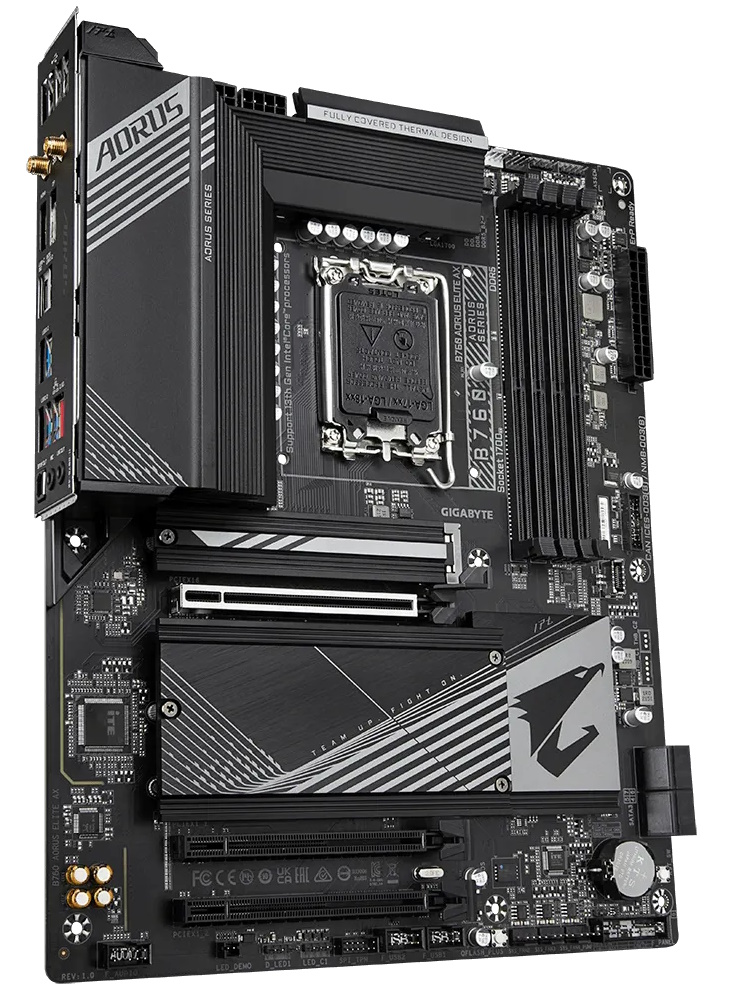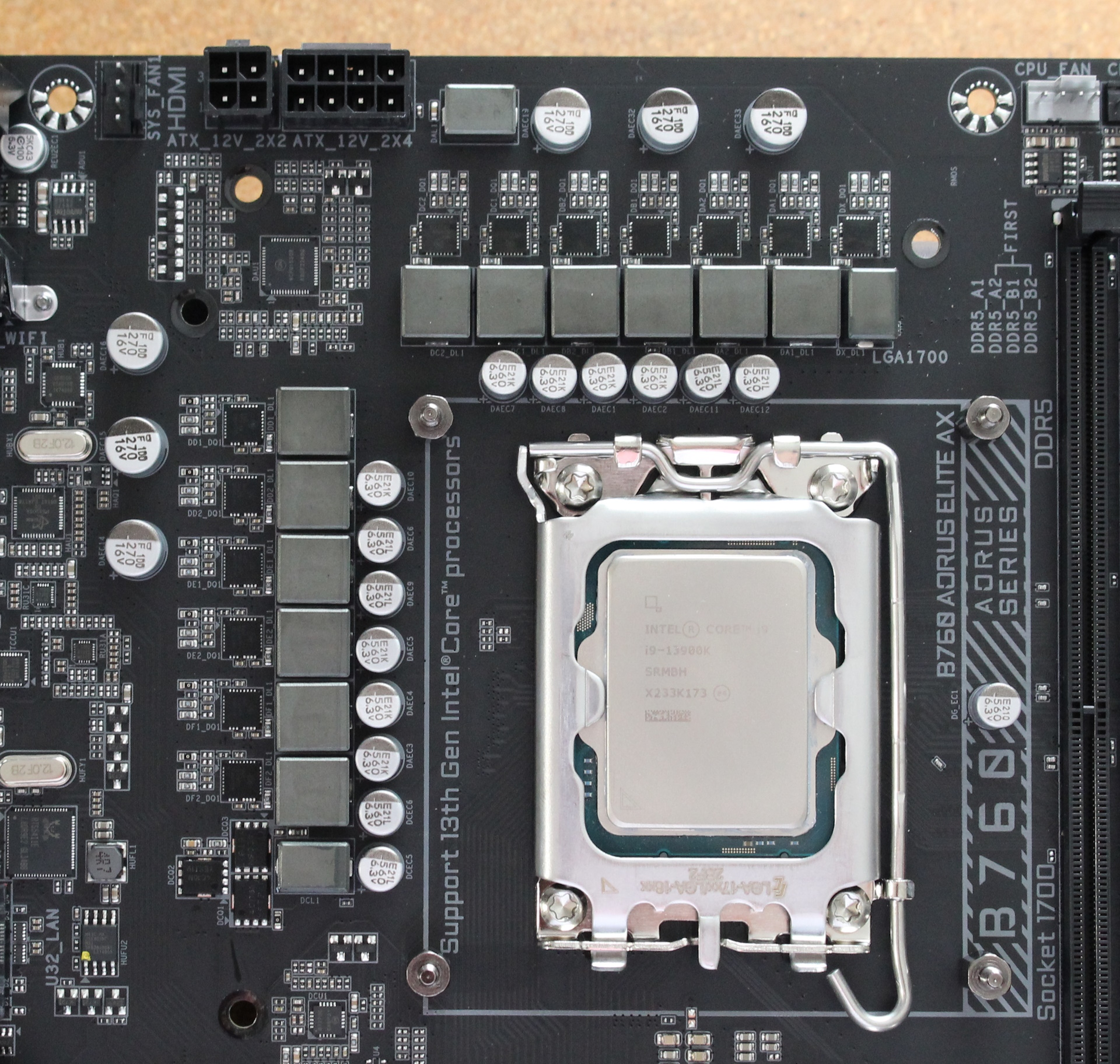Tom's Hardware Verdict
Gigabyte’s B760 Aorus Elite AX is one of the better budget options for your 12th or 13th Gen Intel processor. You get all the basics, including capable power delivery, Aorus’ good looks, ample storage options, and 10 rear IO USB ports. It’s a capable gamer, but you’ll need to adjust the Perfdrive settings for optimal multi-threaded results.
Pros
- +
Good price
- +
10 USB ports on rear IO
- +
Aorus’ good looks
Cons
- -
Lacks 20 Gbps USB port
Why you can trust Tom's Hardware
The Gigabyte B760 Aorus Elite AX on our test bench hails from the budget side of Intel’s motherboard tracks. It's priced at $179.99 at Newegg and reasonably priced overall and among its peers. For the money, you get a full-featured device with DDR5 support, three M.2 sockets and four SATA ports, integrated Wi-Fi 6E, and the familiar Aorus black-and-grey appearance that fits most build themes. It’s a capable, performant (in most tests) motherboard at an affordable price.
Gigabyte has a total of an incredible 48 SKUs on the B760 platform. From the high-end Aorus Master to the base Ultra Durable (UD) line, there must be a configuration and price option suitable for almost any user. The sheer number of options confuses even this seasoned reviewer; the average consumer would almost certainly be overwhelmed trying to decide which is best. Perhaps two of each size motherboard would be sufficient.
The B760 Aorus Elite AX’s performance was hit or miss based on our testing. With the first boot, the board asks you to select your cooling, which sets the power limits. The 3x120mm AIO setting removes the Intel power limits, and the processor runs free up to the thermal throttling point, or whatever the Perfdrive limits you to. To that end, many of our heavily multi-threaded tests were a bit limited due to the default Perfdrive setting, but still competitive versus other B760 boards. If you’re looking to use this system for gaming primarily, it excelled in those tests and is one of the faster overall out of the box.
Priced around $180, the Elite AX is a good value on paper, making it a contender for our best motherboards list if you’re after a budget-conscious Intel option. Before we get into all the details and testing, here is a complete list of the B760 Aorus Elite AX’s specifications direct from Gigabyte.
Specifications: Gigabyte B760 Aorus Elite AX
| Socket | LGA1700 |
| Chipset | B760 |
| Form Factor | ATX |
| Voltage Regulator | 14 Phase (12x 55A SPS MOSFETs for Vcore) |
| Video Ports | (1) HDMI (v2.1) |
| (1) DisplayPort (v1.4) | |
| USB Ports | (1) USB 3.2 Gen 1 (5 Gbps) Type-C |
| (1) USB 3.2 Gen 2 (10 Gbps) | |
| (2) USB 3.2 Gen 1 (5 Gbps) | |
| (2) USB 2.0 (480 Mbps) | |
| Network Jacks | (1) 2.5 GbE |
| Audio Jacks | (2) Analog + SPDIF |
| Legacy Ports/Jacks | ✗ |
| Other Ports/Jack | ✗ |
| PCIe x16 | (1) v4.0 (x16) |
| (2) v3.0 (x1) | |
| PCIe x8 | ✗ |
| PCIe x4 | ✗ |
| PCIe x1 | ✗ |
| DIMM Slots | (4) DDR5 7600(OC), 192GB Capacity |
| M.2 Sockets | (1) PCIe 4.0 x4 (64 Gbps) / PCIe (up to 110 mm) |
| (2) PCIe 4.0 x4 (64 Gbps) / PCIe (up to 80 mm) | |
| SATA Ports | (4) SATA3 6 Gbps |
| Supports RAID 0/1/10 | |
| USB Headers | (1) USB v3.2 Gen 2, Type-C (10 Gbps) |
| (1) USB v3.2 Gen 1 (5 Gbps) | |
| (2) USB v2.0 (480 Mbps) | |
| Fan/Pump Headers | (6) 4-Pin (CPU, System fan) |
| RGB Headers | (2) aRGB (3-pin) |
| (2) RGB (4-pin) | |
| Diagnostics Panel | EZ Debug LED |
| Internal Button/Switch | ✗ |
| SATA Controllers | ✗ |
| Ethernet Controller(s) | (1) Realtek RTL8125GB (2.5 GbE) |
| Wi-Fi / Bluetooth | Intel Wi-Fi 6E AX211 or Realtek Wi-Fi 6E |
| (BT 5.3, 160 MHz, 6GHz) | |
| USB Controllers | Realtek RTS5411E, Genesys Logic GL850G |
| HD Audio Codec | Realtek ALC897 |
| DDL/DTS | ✗ / ✗ |
| Warranty | 3 Years |
Inside the Box of the Gigabyte B760 Aorus Elite AX
In addition to the motherboard, Gigabyte includes a few accessories designed to get you going without another trip to the store. Being a budget-oriented motherboard, don’t expect a plethora of extras. Below is a list of everything included in the box with the board.
- (2) SATA cables
- Wi-fi Antenna
- (2) M.2 standoff screws
- Q-Connector
Design of the B760 Aorus Elite AX



The B760 Aorus Elite AX is made from a 6-layer PCB with 2x Copper, with a matte black appearance. The heatsinks for the power delivery and the M.2 and chipset area have a brushed aluminum finish, along with Aorus branding in gray. The black-on-gray look is neutral, and it should fit in with most build themes.
If you want RGB LEDs, you’ll have to purchase and add your own as the Elite AX does not come with any integrated into the board. You can connect lights to the onboard headers (two RGB and two ARGB), and download the Gigabyte Control Center software to control them through the RGB Fusion application.
Get Tom's Hardware's best news and in-depth reviews, straight to your inbox.
Our tour of the board starts in the upper-left corner, where we run into two EPS connectors (4-pin and 8-pin, the latter required) to power the processor. Also spotted in the same area are the first (of six) 4-pin fan headers. Each header supports PWM and DC-controlled devices, with each able to output 2A/24W. You control these devices through the Gigabyte Control Center software or the BIOS. There are enough headers with plenty of power to connect your fans or water cooling system.
Moving right past the socket area, we next run into four unreinforced DRAM slots with locking mechanisms on both sides. Gigabyte lists support for up to 192GB (4x48GB) and speeds are listed up to DDR5-7600+(OC). The latter is around the median of listed support for the platform. All three of our test kits, up to DDR5-7200, worked without issue by simply enabling the XMP profiles.
Above teh RAM slots are a couple more fan/pump headers and the first two RGB headers, in this case, one 3-pin ARGB and 4-pin RGB. Moving down the right edge, we run into the 24-pin ATX connector that powers the board, as well as front panel USB 3.2 Gen 1 (5 Gbps) and USB 3.2 Gen 2 (10 Gbps) Type-C connectors.
Power delivery on the B760 Aorus Elite AX consists of 14 total phases, with 12 dedicated to Vcore. The Parallel configuration sources power from the 8-pin EPS connector, feeding it to the 8+2 channel OnSemi NCP81530 controller and finally onto the 55A OnSemi MOSFETs before it heads to the CPU. The 660A available isn’t a lot, but it’s enough to handle the flagship Intel i9-13900K we test with, without getting in the way.
On the bottom half of the board, starting on the left, we spy a fully exposed audio section with a few capacitors dedicated solely to sound. The Elite AX, or any board at this price point, doesn’t have a fancy DAC or amplifier, but you can see the fully exposed, budget-oriented Realtek ALC897 chip. While not the latest and greatest, many users will find this acceptable. If not, you can use one of the free PCIe slots (or USB for an external DAC) to add a better solution.
Three PCIe slots and three M.2 sockets are in the middle of the board. Starting with PCIe slots, the top slot, with Ultra Durable Armor and PCIe EZ-Latch, connects through the CPU and runs at a maximum of PCIe 5.0 x16. The bottom slots connect through the chipset and run up to PCIe 3.0 x4.
Mixed in around the PCIe slots are the three M.2 sockets. The top socket hides underneath its own heatsink, connects through the CPU, and runs at PCIe 4.0 x4 (64 Gbps) speeds, supporting up to 110mm drives. The bottom two sockets share a heatsink, connect through the chipset, and run at PCIe 4.0 x4 (64 Gbps). Along the right edge of the board are the four SATA ports (supporting RAID0/1/5/10), reset button, and status LEDs that show problems during POST.
Across the bottom of the board are several more exposed headers. The typical connections include additional USB ports, RGB headers, and 4-pin fan headers. Below is a complete list, from left to right:
- Front panel audio
- 3-pin ARGB header
- 4-pin RGB header
- SPI TPM header
- (2) USB 2.0 headers
- (3) 4-pin fan/pump headers
- Clear CMOS jumper
- Front Panel
Swinging around back the rear IO, a lot is going on for budget-priced board. There are 10 total USB ports, including a 10 Gbps Type-C port. Part of that count includes four USB 3.2 Gen 2 (10 Gbps) and four USB 2.0 (480 Mbps) Type-A ports. The Wi-Fi 6E antenna connections are on the left, while the 2.5 GbE port is on the right next to the 2-plug plus SPDIF audio stack. The only thing we’d like to see here is a 20 Gbps USB port, though we wouldn’t exactly expect that at this price.
MORE: Best Motherboards
MORE: How To Choose A Motherboard
MORE: All Motherboard Content

Joe Shields is a staff writer at Tom’s Hardware. He reviews motherboards and PC components.




